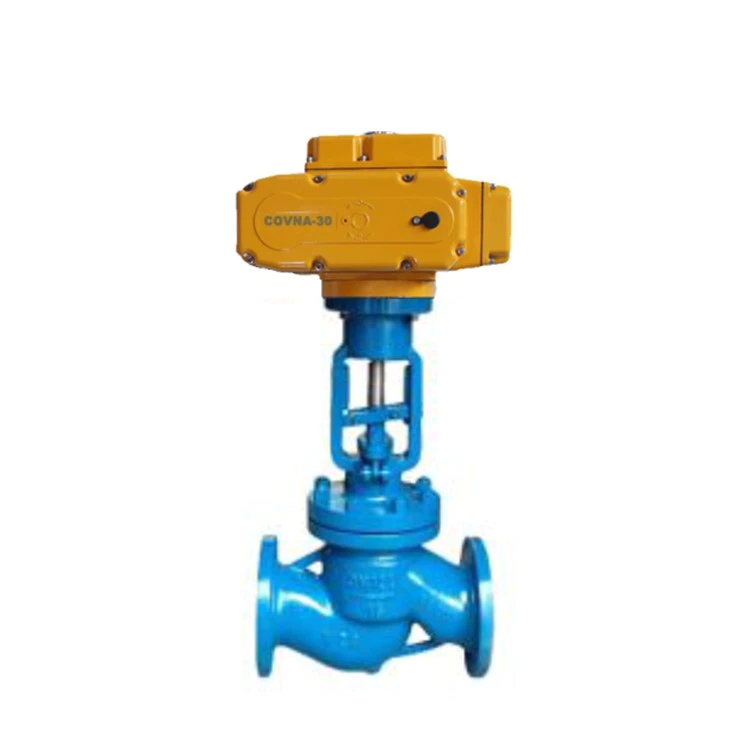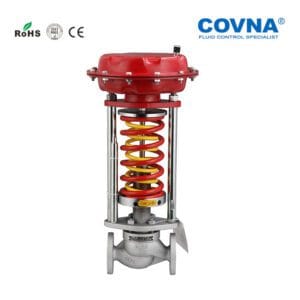COVNA Products

HK60-ZJ Cast Iron Multi-Turn Electric Actuator Shut-Off Valve
Multi-turn actuator valves function differently from ball valves, although both are mounted on pipelines to control water, gas, or any other special chemicals. Within their circular housing is a movable disc and a set of seats, the combination of which can either impede flow or allow more flow. This type of valve features a flanged PN16 connection, simplifying pipeline connections. The cap, bolted to the valve body, seals any flow passing through it, thus allowing all working gases, liquids, and even viscous slurries to be retained without leakage. Due to its construction, this valve has only two ports.
- Model: HK60-Z-J
- Size Range: 2” to 16”
- Pressure Range: 0.6MPa~2.5MPa
- Material: cast iron
Technical Parameters of Valve Actuator
| Power supply | conventional: single phase 220v, three phase 380v |
| special: three phase 400v, 415v, 660v(50Hz, 60Hz) | |
| Working environment | Ambient temperature: -20 ~ + 60 ℃ (special temperature environment can be customized) |
| Relative humidity: 95% (at 25 ° C) | |
| Protection level | Outdoor type and explosion-proof type are IP55 (IP65, IP67, IP68 can be provided for special order) |
| Working system | short time 10 minutes (15-60 minutes for special order) |

Technical Parameters of Valve Body
| Valve Body | Valve components | ||
| Nominal size | DN50-DN400 | Sealing material | PTFE,NBR,EPDM,VITON |
| Body Material | Cast Iron | Disc Material | SS304 |
| End Connection | Flange | Stem Material | Cast iron, WCB, SS316 |
| Operating Pressure | 1.0 / 1.6 / 2.0 / 2.5 MPa | Applicable media | Water, Air, Gas, Oil, Liquid |
| Structure | Midline structure/A-Type | Design standard | ANSI, JIS, DIN, BS, GB |

The actuator on my automated valve operates, but the valve won’t turn. Why?
Most likely the valve stem or actuator coupling is broken.
Why doesn’t my valve open or close completely when the actuator operates it?
The electric actuator limit switches or the pneumatic actuator position stops are not correctly adjusted.
When I energize the solenoid on my pneumatic actuated valve, the valve won’t turn. How come?
Probably because there is no air pressure to the solenoid or dirt has jammed it. Also, debris might be trapped inside the valve. Or, the air pressure is not sufficient to operate the actuator. Remember: measure air pressure at the actuator, not at the compressor.
Can I buy an actuator from one manufacturer and mount it to a valve from another manufacturer?
Maybe. First, be sure that the actuator torque output is sufficient to turn the valve reliably. Second, you will have to fabricate a custom mounting bracket and coupling to connect the actuator to the valve.
What happens if I lose power to my electric actuator in the middle of an actuation cycle?
The valve will stop somewhere between full open and close. When power is reapplied to the original circuit, the actuator will complete the cycle.
I ordered a fail open pneumatic actuated valve by mistake. I needed a fail closed one. What can I do?
To make the change just remove the actuator from the valve and turn it, or the valve stem, 90 degrees and remount the actuator.
I’ve installed my automated valve in the line, but now I don’t know if the valve is in the open or closed position. How can I find out?
Remove the actuator from the valve and check the valve stem. Most ball valves have stem flats at right angles to the flow when the valve is in the off position. On butterfly valves check the stem flow arrow marking.
Do I have to have the solenoid valve that controls the air supply to my pneumatic actuator mounted right on the actuator?
Remove the actuator from the valve and check the valve stem. Most ball valves have stem flats at right angles to the flow when the valve is in the off position. On butterfly valves check the stem flow arrow marking.
How do I wire up my electric actuator?
Check the electric wiring schematic that came with the actuator for the correct hookup. Sometimes a copy is inside the actuator cover. If it is missing, don’t guess about the connections. Call the manufacturer for a schematic.
I’ve just installed an electric actuated valve and when I power it, it turns the valve 360 degrees and won’t shut off. What’s wrong?
The actuator is wired incorrectly (check the schematic accompanying the actuator), or the external control switch is not the correct type for the actuator.
My electric actuators cycle time is way too fast, can I slow it down?
Not unless you bought it with an optional speed control.
I just replaced a solenoid valve with an electric actuated valve and it won’t work. Why?
Actuators and solenoid valves require different types of electrical control switches. SPDT for actuators, SPST for solenoids. Check the actuator wiring schematic for the correct wiring and switch type.












